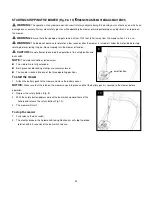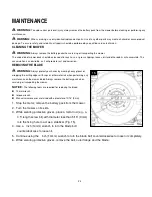
10
◼
Check the blade and motor mounting bolts at frequent intervals for proper tightness. Also, visually inspect the blade for damage
(e.g., bending, cracking and wear.). Replace the blade only with the identical replacement blade, as listed in this manual.
◼
Maintain your mower with care
–
keep the mower blade sharp and clean for the best and safest performance. Mower blades
are sharp and can cut. Wrap the blade or wear gloves and use extra caution when servicing it.
◼
Keep all nuts, bolts, and screws tight to be sure the equipment is in safe working condition.
◼
Never remove or tamper with safety devices. Regularly check their proper operation. Never do anything to interfere with the
intended function of a safety device or to reduce the protection provided by a safety device.
◼
Always stop the motor before making adjustments to a wheel or a cutting-height adjustment.
◼
After striking a foreign object, stop the motor, remove the battery pack, allow the blade to stop rotating, and thoroughly inspect
the mower for any damage. Repair the damage before operating the mower.
◼
Maintain or replace safety and instruction labels, as necessary.
◼
Ensure that batteries are charged using the correct charger recommended by the manufacturer. Incorrect use may result in
electric shock, overheating or leakage of corrosive liquid from the battery.
◼
Always wear gardening gloves when handling or working near the sharp blades.
◼
SAVE THESE INSTRUCTIONS.
Refer to them frequently and use them to instruct others who may use this tool. If you
lend this tool to someone else, also lend these instructions to them to prevent misuse of the product and possibly injury.
Recommendations for Optimal Handling of the battery
◼
Ensure the switch is in the off position before inserting battery. Inserting the battery into machines that have the switch on
invites accidents.
◼
Keep the battery charger away from rain or moisture. Penetration of water in the battery charger increases the risk of an electric
shock.
◼
Recharge only with the charger specified by the manufacturer. A charger that is suitable for one type of battery may create a
risk of fire when used with another battery.
◼
Do not charge other batteries. The battery charger is suitable only for charging lithium ion batteries within the listed voltage
range. Otherwise there is danger of fire and explosion.
◼
Keep the battery charger clean. Contamination can lead to danger of an electric shock.
◼
Before each use, check the battery charger, cable and plug. If damage is detected, do not use the battery charger. Never open
the battery charger yourself. Have repairs performed only by a qualified technician and only using original spare parts.
Damaged battery chargers, cables and plugs increase the risk of an electric shock.
◼
Do not operate the battery charger on easily inflammable surfaces (e.g., paper, textiles, etc.) or surroundings. The heating of
the battery charger during the charging process can pose a fire hazard.
◼
Use only batteries intended specifically for the machine. Use of any other batteries may create a risk of injury and fire.
◼
When battery is not in use, keep it away from other metal objects like paper clips, coins, keys, nails, screws, or other small
metal objects that can make a connection from one terminal to another. Shorting the battery terminals together may cause
burns or a fire.
◼
Do not open the battery. Danger of short-circuiting.
◼
Protect the battery against heat, e.g., also against continuous sun irradiation and fire. There is danger of explosion.
◼
Do not short-circuit the battery. There is danger of explosion.
◼
In case of damage and improper use of the battery, vapors’ may be emitted. Provide for fresh air
,
The vapors’ can irritat
e the
respiratory system.
◼
Protect the battery against moisture and water.











































